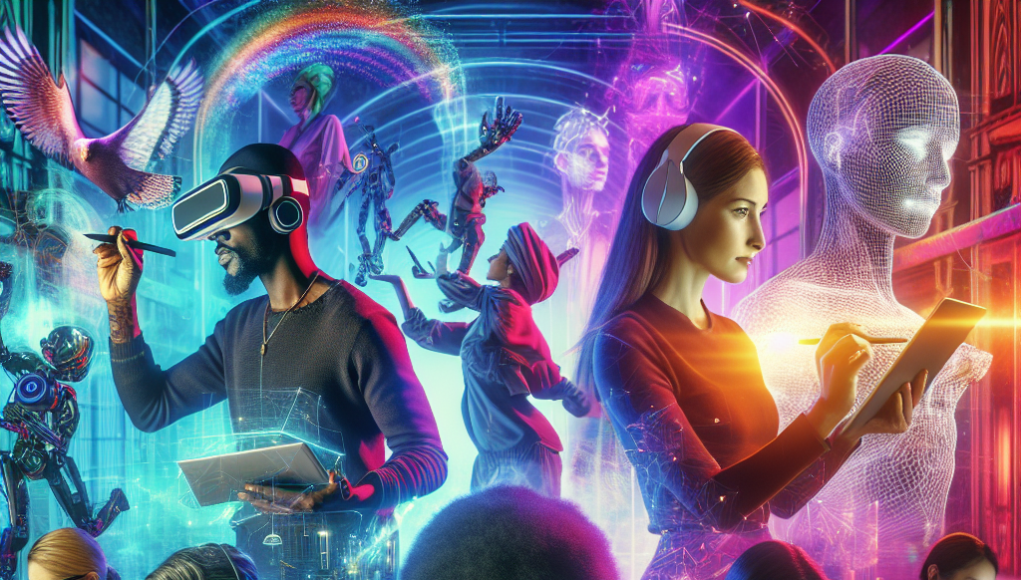Emerging Voices: Today’s Innovators in Digital Art
The digital art landscape is a dynamic and ever-evolving realm, where innovation and creativity converge to redefine the boundaries of traditional artistic expression. In an era where technology is intricately woven into the fabric of artistic creation, emerging voices are at the forefront, pioneering new techniques, tools, and narratives. This article explores the pioneers of digital art innovation, examines the impact of these emerging voices on modern art, and delves into the techniques and tools shaping the future of creative expression.
Exploring the Pioneers of Digital Art Innovation
The digital art world has witnessed the rise of numerous pioneers who have ventured beyond conventional artistic boundaries to explore uncharted territories. These trailblazers are not only redefining the concept of art but are also challenging the very essence of creativity itself. Artists like Refik Anadol, known for his immersive data-driven installations, are pushing the boundaries of what digital art can achieve. By transforming raw data into captivating visual experiences, Anadol and his contemporaries are opening up new avenues for artistic exploration.
In the realm of digital illustration, artists such as Loish and Pascal Campion are making waves with their unique styles and innovative approaches. These artists seamlessly blend traditional drawing techniques with digital tools, creating artworks that resonate with audiences on both emotional and aesthetic levels. Their ability to harness the power of digital mediums while maintaining a personal touch sets them apart as pioneers in their field.
One cannot discuss digital art pioneers without mentioning the impact of NFTs (Non-Fungible Tokens). Artists like Beeple have revolutionized the art market by embracing blockchain technology, allowing digital artworks to be bought, sold, and owned in unprecedented ways. This shift has empowered artists to gain greater control over their work and has opened up new revenue streams, challenging traditional art market dynamics.
Another significant aspect of digital art innovation is the exploration of new media and technologies. Artists like Jenny Holzer and Rafael Lozano-Hemmer are incorporating augmented reality, virtual reality, and interactive installations into their work. These pioneers are not only expanding the possibilities of artistic expression but are also engaging audiences in immersive experiences that transcend the boundaries of traditional art forms.
The pioneers of digital art are not limited to visual artists alone. Musicians, writers, and performers are also exploring the digital realm, creating multidisciplinary works that blur the lines between different art forms. This convergence of disciplines is driving innovation, fostering collaboration, and expanding the horizons of what is possible in the digital art landscape.
In conclusion, the pioneers of digital art innovation are reshaping the artistic landscape by embracing new technologies, exploring novel media, and challenging conventional notions of creativity. Their contributions are not only redefining the boundaries of art but are also inspiring a new generation of artists to push the limits of their own creativity.
The Impact of Emerging Voices on Modern Art
Emerging voices in digital art are having a profound impact on modern art, challenging traditional norms and redefining artistic expression. These artists are not only pushing the boundaries of what is considered art but are also influencing how art is perceived, consumed, and valued in contemporary society. Their fresh perspectives and innovative approaches are breathing new life into the art world.
One of the most significant impacts of emerging voices in digital art is the democratization of artistic creation. Digital tools and platforms have made art more accessible to a broader audience, breaking down barriers that once limited artistic expression to a select few. Emerging artists are leveraging social media, online galleries, and digital marketplaces to showcase their work, connect with audiences, and gain recognition on a global scale.
Moreover, emerging digital artists are challenging the traditional notions of authorship and ownership. The rise of collaborative creation and open-source platforms has fostered a culture of sharing and remixing, where artists build upon each other’s work to create something entirely new. This shift is redefining the concept of originality and encouraging a more inclusive and interconnected artistic community.
The impact of emerging voices is also evident in the way art is consumed and experienced. Digital art has opened up new possibilities for interactive and immersive experiences, allowing audiences to engage with art in ways that were previously unimaginable. From virtual reality exhibitions to interactive installations, digital artists are transforming passive viewers into active participants, creating a more engaging and dynamic art experience.
Furthermore, emerging voices in digital art are addressing pressing social, political, and environmental issues through their work. These artists are using their platforms to raise awareness, spark conversations, and inspire action. By leveraging the power of digital media, they are reaching diverse audiences and driving meaningful change, making art a powerful tool for social impact.
In summary, the impact of emerging voices on modern art is profound and far-reaching. They are democratizing artistic creation, challenging traditional norms, and redefining how art is consumed and experienced. Their innovative approaches and fresh perspectives are reshaping the art world and inspiring a new generation of artists to explore the possibilities of digital expression.
Techniques and Tools Shaping Tomorrow’s Creatives
The techniques and tools employed by today’s digital artists are constantly evolving, shaping the future of creative expression. As technology advances, artists are embracing new methods and platforms that allow them to push the boundaries of their craft and explore new dimensions of artistic creation. These innovations are not only transforming the way art is made but are also influencing how it is perceived and understood.
One of the most significant developments in digital art is the rise of artificial intelligence (AI) as a creative tool. Artists are using AI algorithms to generate unique compositions, explore new styles, and even collaborate with machines in the creation of art. This fusion of human creativity and machine intelligence is opening up new possibilities for artistic expression and challenging traditional notions of authorship and creativity.
In addition to AI, virtual reality (VR) and augmented reality (AR) are revolutionizing the way artists create and audiences experience art. These immersive technologies allow artists to construct entire worlds and invite viewers to step inside, offering a level of engagement and interaction that was previously unattainable. As VR and AR continue to evolve, they promise to reshape the art world and create new opportunities for artists and audiences alike.
Another tool that is shaping the future of digital art is blockchain technology. The rise of NFTs has provided artists with new ways to monetize their work and establish provenance and ownership in the digital realm. This technology is not only transforming the art market but is also empowering artists to gain greater control over their creations and connect directly with collectors and fans.
Furthermore, digital artists are leveraging a wide range of software and hardware tools to enhance their creative process. From graphic design software like Adobe Creative Suite to digital drawing tablets and 3D modeling programs, these tools are enabling artists to experiment with new techniques and push the limits of their creativity. The accessibility and versatility of these tools are empowering a new generation of artists to explore digital art and discover their unique voice.
In conclusion, the techniques and tools shaping tomorrow’s creatives are diverse and ever-evolving. From AI and immersive technologies to blockchain and digital design software, these innovations are transforming the way art is created, consumed, and understood. As artists continue to explore the possibilities of digital expression, they are paving the way for a future where creativity knows no bounds.
The world of digital art is a vibrant and dynamic landscape, where emerging voices are leading the charge in redefining artistic expression. These innovators are not only pushing the boundaries of creativity but are also transforming the way art is created, consumed, and valued. As the techniques and tools of digital art continue to evolve, they offer new possibilities for artists to explore and inspire a new generation of creatives. In this ever-changing landscape, the pioneers of today are shaping the future of art, creating a world where innovation and imagination know no limits.










